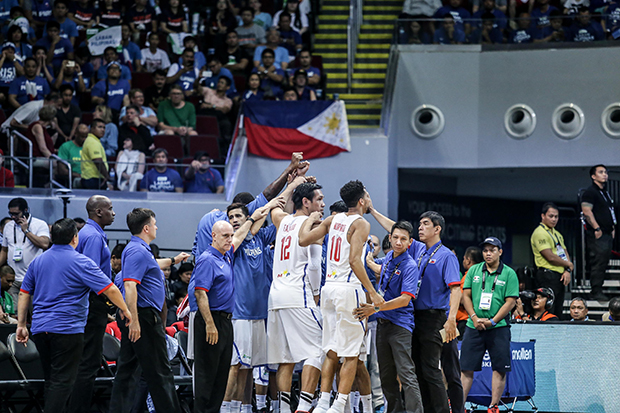
Gilas Pilipinas vs New Zealand in a FIBA OQT match at Mall of Asia Arena. Photo by Tristan Tamayo/INQUIRER.net
Was the Fiba Olympic Qualifying Tournament the last time we have seen Filipino professional players donning the national tri-colors?
Chances are high with Fiba instituting a new calendar starting in 2017.
Home-and-away games will be played between national teams in four competition windows scattered across the year, with teams obtaining points to help in their qualification for the regional tournaments, the Fiba Basketball World Cup, and the Olympics.
READ: De Ocampo retires from Gilas
Following Gilas Pilipinas’ heartbreaking 89-80 defeat to New Zealand on Wednesday that ousted the Filipinos from the FIBA OQT, Ranidel de Ocampo announced his retirement from international competition.
Key cogs like Jayson Castro and Marc Pingris are also considering hanging up their kicks from the national team, leaving a lot of doubts with the future of Gilas.
Meanwhile, the Samahang Basketbol ng Pilipinas (SBP) is set to revive the Gilas cadets program and has enlisted top collegiate stars to join the team.
READ: Pingris: Gilas can’t win with talent alone
This move could prove to be beneficial, allowing the Philippines to have a team ready for these home-and-away games.
But this comes with a caveat, as professional players’ participation is expected to be doubtful with the competition windows scheduled in the middle of the PBA season.
PBA deputy commissioner Rickie Santos said that there’s still a chance professional players can reinforce the national team.
“It’s a part of PBA’s commitment with the national team,” he said.
READ: FIBA OQT: New Zealand ends Gilas Pilipinas’ Rio dream
However, only players from eliminated squads could bolster the national team and are still subject to the decision of their mother teams.
“That is still pending the approval of the player, the mother, and the PBA.”
“It’s not just for the cadets. It’s an old rule that when a player will be lent elsewhere during the break, there should be an approval from all three,” Santos continued.
READ: Uytengsu to SBP: Let Gilas Cadets join PBA Draft
This move is reminiscent of the system back in 2012 when the likes of Asi Taulava and Dondon Hontiveros bolsteredthe Rajko Toroman-coached Smart Gilas team.
But this could only be the PBA’s lone contribution to the national team moving forward.
A source who requested anonymity said that there is little to no chance the PBA bumps its schedule anew to conform to the new Fiba calendar.
READ: Baldwin: Switch to old Gilas program beneficial for cadets, country
“The owners are already hesitant to adjust to the schedule,” he said.
For the PBA’s part, Santos explained the difference of the Philippines from the neighboring countries is the length of the PBA season.
“The PBA is unique because it is the only league that has a season spanning 10 and a half months. Other leagues usually have seasons running from six to eight months at most,” he said.
READ: New Gilas cadets program targets 2019 Fiba World, 2020 Olympics
The source also said that allowing players to comprise an all-pro team, just like in 2002, didn’t do anyone any good and is unlikely to happen again.
Cadets problem?
Despite the reprieve provided by the entry of the cadets in the national team program, it also comes with its own set of issues.
With the top amateur standouts expected to participate in the program, that guts out the pool for the 2016 PBA Rookie Draft.
Another source close to the situation said that the possibility of allowing these young players join the draft just for teams to secure their rights or holding a separate draft for the Gilas cadets-bound players have been bounced around.
READ: SBP, PBA discuss Gilas cadets options
But the issues don’t end there. Concerns like the cadets’ commitments to the program, the longevity of the contracts—both with Gilas and the mother ballclubs—the possibility of an opt-out clause, and the continuity of the program with the next wave of prospective collegiate players all being tackled.
Both the SBP and the PBA are in constant communication with repeated meetings set to iron out these issues.